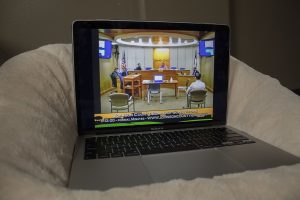Iowa hospital officials hopeful on vaccine, continuing surge plan
As University of Iowa Health Care officials have prepared for the current surge in hospitalizations, they are also looking to a vaccine on the horizon.
Photo Illustration by Katie Goodale
November 18, 2020
University of Iowa Hospitals and Clinics officials discussed plans to combat the surge in COVID-19 cases in Iowa and gave vaccine trials updates at the state Board of Regents’ virtual meeting Wednesday.
Due to the spike in COVID-19 cases in the U.S. and across Iowa, UIHC has made changes to staffing on COVID-19 floors and changing guidelines for staff members. UI Vice President for Medical Affairs Brooks Jackson told the regents that this first phase of handling increasing cases of COVID-19 will continue until the end of the year.
“As the only comprehensive academic medical center in the state of Iowa, we have a unique responsibility as the safety net for the rest of the state,” he said. “As such the primary goal of our current efforts, is to ensure that our health system can continue to support the rest of Iowa’s hospitals and ensure that health care needs of all Iowans can continue to be met during the surge.”
This phase, Jackson said, is a fundamental change to the hospital’s operations that is meant to protect frontline workers.
Jackson thanked health-care workers for the sacrifices they’ve made for their communities while reminding Iowans to follow COVID-19 guidelines. He urged individuals to be responsible this holiday season and stay home.
UIHC Chief Executive Officer Suresh Gunasekaran also spoke at the regents meeting Tuesday. He said the hospital hit another peak of COVID-19 patients today with 100 of 850 beds being taken up by patients with the virus.
“Today, we are not overwhelmed, but if we had not been working on creating this additional capacity, we would be full,” he said. “The one thing that I’m privileged to be able to do, being part of such a great university and part of such a great medical center is we have the assets, not just the beds, not just the equipment, not just the ventilators, not just the air handling, but really the talented faculty and staff that can be deployed in numerous configurations to really deliver safe care and appropriate care for Iowans during this pandemic.”
Gunasekaran said he expects a new phase of the surge plan to come out next week unless something drastically changes.
The board also heard a presentation Tuesday about the vaccine trials at UIHC from Patricia Winokur, the executive dean of the Carver College of Medicine and director of the Vaccine Treatment and Evaluation Unit.
In an update on the Pfizer and Moderna vaccines, Winokur said Pfizer is expected to send its data to the FDA today or tomorrow following the third phase of the study. She said Moderna is a few weeks behind.
Both vaccines have reported over a 90 percent efficacy rate in recent days, something Winokur said was extremely uncommon and a reason for hope.
“Ninety-five percent effective is really good. This is getting into the efficacy rates of measles, and it will help us really flatten the curve much faster,” she said. “… Flu vaccines in many years are about 50 percent protective in young, healthy people. Typically, it’s been 70 percent effective. Some years are better than others, so this is much better than what we’ve seen of typical flu vaccines.”
A concern that has been on the forefront of the team’s approach to the vaccines is distribution, Winokur said. Once one of the vaccines receives FDA approval, she said the question will turn to how the vaccine will be distributed and who will have access to it.
“I think the earliest vaccine availability is probably going to be mid-December, maybe to the third week in December,” she said. “We will have limited doses and it is going to be important to distribute them appropriately.”
She said the Advisory Committee on Immunization Practices will advise the CDC and FDA on how to distribute these scarce vaccines.
“They’ll describe the priority populations and the sequencing,” she said. “And then the distribution is going to be coordinated in Iowa through the department of public health, in conjunction with the CDC. We still have a lot to learn about this vaccine.”
The two front-running vaccines are two-dose vaccinations, said Winokur. However, the times in between the shots vary depending on the company. Winokur said the shots should be separated by 20-28 days.
Winokur said symptoms were minimal — those who receive the vaccine could be fatigued 24-48 hours after the shot, but that people were still able to continue to work with over-the-counter pain relievers such as Tylenol or Ibuprofen
Patient Care
Regardless of COVID-19, Gunasekaran said the hospital is still working to improve its quality of care. He said the hospital has been working to improve everyday care while continuing to treat patients with coronavirus.
UIHC has improved its patient satisfaction, Gunasekaran said. Patients were satisfied by their communication with nurses and doctors on staff at the hospitals as well as the responsiveness of the hospital, he said.
Gunasekaran said there is still room to improve, especially when it comes to the responsiveness of the hospital and the quietness of the hospital – which is at a lower percentage of satisfaction due to the business of UIHC. Patient satisfaction has flattened during the pandemic at UIHC, he said, while it has gone down in several comparable hospitals around the country.
“I wanted the board to see that we do monitor this, we do take this seriously, and you can’t quit listening to the voice of the patient just because of the pandemic,” he said. “And I will also note to you that full transparency, there has been an increase in patient complaints during the pandemic as well.”
He said most of the complaints have been about visitor restrictions and communication. While the COVID-19 pandemic continues, Gunasekaran said the quality of care at UIHC will remain high as it has in the past few years.
“We need to refortify on the other side of the pandemic to make sure we’re continuing to put our best foot forward,” he said.







